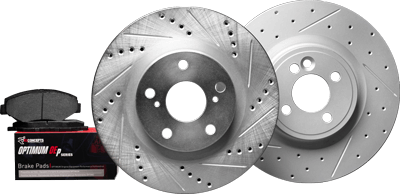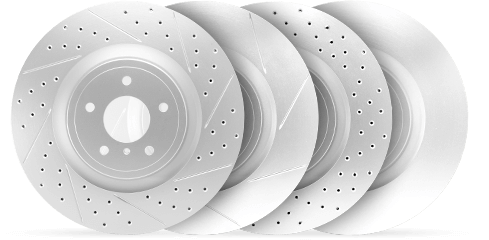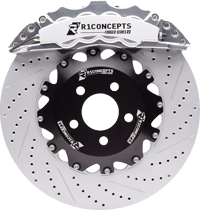R1 Concepts explains causes and signs of warped rotors and how to determine if your brake discs are warped. Read more or shop rotors online now!
There are three common causes of brake rotor warping or failure:
- Extended Parking: Vehicles that are parked for an extended period of time can build up surface rust. Most often, these rotors can not be machined out. However, if they can be turned, you might put the rotors under specification.
- “In-Town” Driving or “Rush Hour” Driving: A lot of “in-town driving” or driving during “rush hour” traffic of course requires a lot of stopping. That can build up excessive heat in the brake rotors and cause it to warp. (Tip: Maintain a fair distance, and avoid “riding the brakes” lightly as this does little to stop you, while generating excessive heat.)
- Incorrect Fitting: Unless a torque tube is also used, the use of air tools to fasten lug nuts should be avoided. Sandwiching the brake rotors in place by the wheel while tightening the lug nuts unevenly can cause the brake discs to warp. Some vehicles are sensitive to the force the bolts apply and tightening should be done with a torque wrench. (TIP: Never tighten your wheels in a circle pattern; follow the vehicle manual).
If your rotors warp more than five thousandths of an inch, or .005, you will be able to feel it when you apply the brakes.
- Pulsation in the brake pedal: When you apply the brakes, the brake pedal will pulsate; it will push back at you. The cause of this pulsation is because as the rotor rotates into the brake pads and you have the pads applied to the brake rotors, that warp or fad spot on the rotor will cause a hydraulic pressure surge; it will force the brake pads apart, and cause that surge to go backwards thru the system, through the master cylinder, and into your brake pedal.
- Pulsation in the steering wheel: At higher speeds, you will also notice the warping when you apply the brakes and the steering wheel shake or vibrate. You will feel the vibration transferred through steering linkage into the steering wheel; it may cause the whole vehicle to shake and shutter and you’ll definitely feel it up front if it happens to be one of the front brake rotors. Some of them can shake quite violently. If the warping happens to be only in the rear of the vehicle, you notice it more so in the seat or coming from the back of the vehicle.
- Stress Cracks: Stress cracks are small “flake” style cracks all over the surface of the rotors. The visibility of these cracks indicate excessive heat or excessive wear. If the rotor has been worn too thin from machine work or turning, it is not able to dissipate its heat properly. When you are machining a brake rotor (“turning”), you are actually removing metal and making it a smaller and thinner part. In my opinion it undermines the structural integrity of the rotor.
Shameless plug: We offer OE quality brake rotors at very affordable prices. Check us at www.r1concepts.com or call us toll-free 888-712-6623 and we’ll be glad to assist you. Often times, the price for brand new brake rotors are less than what it would cost you to turn them. So give us a try.









